Art & Architecture
 |
 |
 |
 |
 |
 |
 |
Analyzing Van Eyck's Mystical Lamb
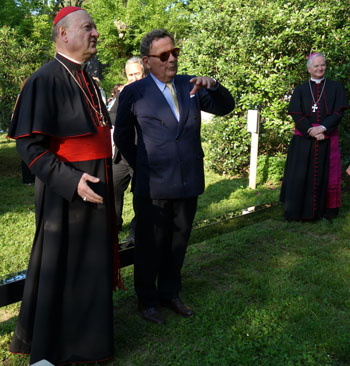
Card. Ravasi, left, with curator Francesco Dal Co, at the unveiling of the Vatican's exhibition space
She was concerned that there might be something objectionable about this painting since she had heard that many Renaissance artists used occult or gnostic symbols in their works.
Indeed, this is true of many famous Italian Renaissance painters, such as Leonardo da Vinci, Michelangelo and Botticelli, to name a view, whose works abound with homoerotic images and have underlying gnostic themes.
It is my opinion that the 15th century Flemish School of Painting – Jan van Eyck is one of its important masters – still represented much of the spirit of the Middle Ages. This follows the opinion of other art analysts who point out that painting schools take longer than other arts to reflect the influences of their times.
At any rate, it would appear that the Flemish painters of that time were much less affected by the Italian Renaissance. It was only in the early 16th century that this influence became more notable.
Jan van Eyck became known for his exquisite detail, material splendor, brilliant coloring, naturalistic rendering of reality, and heavy use of symbolism - all present in this monumental piece. This central altarpiece scene is so filled with figures and objects that it can certainly appear confused to the modern eye. It would not be surprising for a man of our century to have suspicions: "What is going on here? Is this some cult to nature?"
No, not at all. The artist had a meaning for each part of this scene, as well as the whole altarpiece. He intended to express a rich Catholic symbolism of the redemptive mysteries of the Catholic Faith.
The Lamb of God
In the center of the painting is the Lamb bleeding into a golden chalice, a symbol of the Our Lord Jesus Christ in the Holy Eucharist. The Lamb is Christ Who shed His Blood on Calvary and in a bloodless way renews His sacrifice daily on the altar.

Card. Ravasi, left, with curator Francesco Dal Co, at the unveiling of the Vatican's exhibition space
Salvation belongs to our God who is seated on the throne, and to the Lamb" (Apoc 7:10). The Mystical Lamb, His sacrifice complete, no longer feels pain. His contemplative, unearthly gaze has a divine air. His Blood flows from his chest into a chalice, a symbol of its redemptive value. Our Lord shed every drop of His Blood to save mankind from eternal death; not a drop was wasted. This is the heart of the Ghent Altarpiece.
The four-part procession
This Lamb on the altar contemplates us, as if inviting us to join the four-part procession taking place on that canvas.
Closest to the viewer are two processions moving toward the altar of the Lamb. The group on the left consists of kneeling Prophets and Patriarchs from the Old Testament who awaited and foretold the coming of Christ. Behind them are a collection of pagan poets and philosophers whose garb and headgear indicate they come from all over the world. The figure in white holding a laurel wreath is generally held to be Virgil, who predicted the coming of the Savior in his Fourth Eclogue. Isaiah stands to his side holding a twig, a symbol of his own prophecy of the Redeemer (Is 11:1).

Card. Ravasi, left, with curator Francesco Dal Co, at the unveiling of the Vatican's exhibition space
In the background and to the left, a group of men represents the Confessors of the Faith, along with Prelates, abbots and monks. On the right another group of women bearing palm leaves and wearing crowns of flowers signify the Virgin Martyrs. We can recognize some by their symbols: St. Agnes carries a lamb, St. Barbara a tower, St. Ursula an arrow.
All these groups are processing toward the Lamb of God, Our Lord Jesus Christ (Jn 1:29, 36). It is as if the painter is illustrating a phrase from the Apocalypse: "The Lamb is the Lord of lords and the King of kings, and those who are with Him are the called and chosen and faithful" (17:14)

Card. Ravasi, left, with curator Francesco Dal Co, at the unveiling of the Vatican's exhibition space
In the background landscape we find flowers from all seasons and different countries, again, a symbol that Christ came to shed His Blood for all nations. Far into the background, tall mystical buildings represent the New Jerusalem, the symbol of the Catholic Church, the bride of Christ. As such it exists both in Heaven and on earth through the communion of Saints.
As we see, everything has a religious meaning, one layer upon another. The dove in the picture symbolizes the Holy Spirit Who sheds His gifts and graces on mankind. Emphasizing the doctrine of the Mass as the source of eternal grace is the water coming from the Fountain of Life. Crystalline drops flowing from the fountain appear to be falling even outside the painting and onto the viewer.
The message is clear: The Blood of Christ washes away sin and gives us eternal life. A Latin inscription on the altar states: Ecce Agnus Dei qui tollit peccata mundi. "Behold the Lamb of God who takes away the sins of the world" (Jn 1:29). It is, indeed, the Lamb of God who is ever on the altar surrounded by the redeemed who always worship and praise Him.
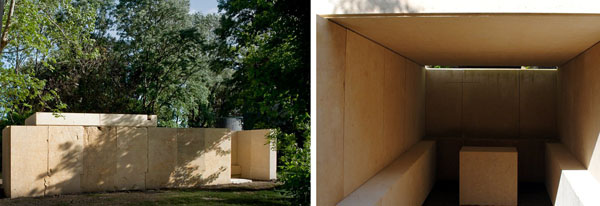
A final note remains to be said about the remarkable history of the Ghent Altarpiece. In 1566, all hell broke loose in Ghent. Protestant militants broke down the Cathedral doors with an improvised battering ram, intending to burn this grand work of art, which they considered to be an example of Catholic idolatry and excess. But alert Catholic guards had disassembled the enormous work and hidden it in the cathedral tower, where it survived unscathed.
Over the next few centuries, the Ghent Altarpiece was taken as booty in the Napoleonic Wars and then returned to Ghent. Parts of it were stolen by a vicar at St. Bavo and ended up, after several sales, in a Berlin museum. The panels were reunited at the Cathedral as part of the arrangements of the Treaty of Versailles.
Finally, the altarpiece returned to its original home, Saint Bavo Cathedral in Ghent, where it can be viewed today, much of it already restored marvelously in a project that is still ongoing
In this year’s Venice Architecture Biennale, the Vatican outdoes itself in proving its adaptation to the modern world. Vatican involvement in this avant-garde, ugly display of structures is enthusiastically explained as being yet “another step towards healing the rift between the spiritual and the secular” by Cardinal Gianfranco Ravasi, president of the Pontifical Council for Culture.
The Vatican’s first leap into the 2013 Art Biennale, an initiative of Pope Benedict XVI, was titled Creation, UnCreation and Recreation. The three exhibit rooms emphasized the respect for nature and the environment and bemoan the Jewish “holocaust,” but included no reference whatsoever to God and His role in Creation.
At the 2015 show, in the Vatican’s central space there was an ongoing reading of Marx’ Das Kapital and a room exhibiting voodoo heads and obscene nude “porn dollies.”
This year the Vatican marked another first by making a contribution to the Venice Biennial Architectural event. Card. Ravasi hired 10 leading-edge architects to design 10 temporary chapels (obviously not an inexpensive project). Normally I am firmly opposed to the conciliar Pope’s efforts to diminish and minimize the Church by selling her riches to give to the poor; in this case, I believe the money spent for this extravagant and imbecile enterprise would have been better spent on alms.
An ecumenical space
On May 27 at 6 p.m. Venice time, the Vatican unveiled its 10 chapels in the outdoor space assigned to it – a wooded area on the of San Giogio Maggiore Island. The crowd was dense as the line formed to be ushered through the first view of the “prayer spaces."
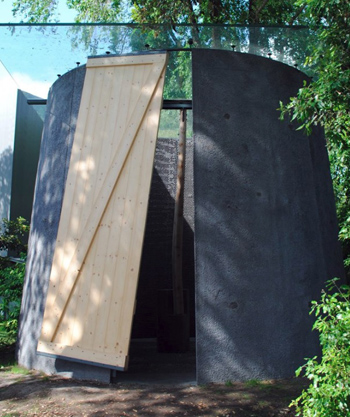
This open-roof silo structure is supposed to be a roadside shrine, or "tribalized chapel"
The so-called Catholic chapels are thus planned to be totally ecumenical, with the only acceptable symbol a plain cross so as not to provoke the sensibilities of Protestants, Muslims, Jews, Buddhists, etc.
When the project was announced in March, Card. Ravasi said that visiting the 10 chapels would serve as a sort of “pilgrimage.” That this is not a Catholic religious pilgrimage is obvious from the start.
Monstrosities unveiled
Brazilian architect Carla Juaçaba’s contribution, below left, represents the minimalist, better said Miserablist Church to the tee. That’s all there is to it, a single polished steel plank T-shaped structure that can or cannot be a cross, depending on your opinion.
Rivaling it in witless simplicity is the carport structure designed by New York architect Andrew Berman, below right. This chapel made of wood and polycarbonate is his first “explicitly religious building,” although I don’t know what the normal man can find of religious in this communist shed.
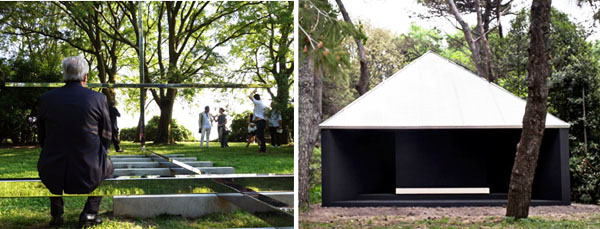
Portugal’s Eduardo Souto de Moura’s contribution below was an underground “space” enclosed by four stone walls, and benches on the side so the visitors can sit and contemplate a stone at the center that alludes to an altar. The covering for this subterranean room looks more like a bus stop with outdoor lavatories than anything to do with the Catholic Religion prior to Vatican II.
A crossbeam serves as an obscure cross in British designer Norman Foster’s slatted wood frame "chapel," below left. Here one is asked to meditate not on Christ but rather on the nearby forest and water. It is a "nature sanctuary.” The architect's explicit aim is to move worship outside the traditional chapel to the “water and sky beyond.”
To the right below, you find Australian Sean Godsell's pop-up chapel, a strange silo-like structure that rests on a carport. It can be transported, erected, re-packed, transported, re-erected again wherever the need exists. The notion of a stable and beautiful Church that calls people by its grandeur to enter and contemplate God and His mysteries has completely disappeared.
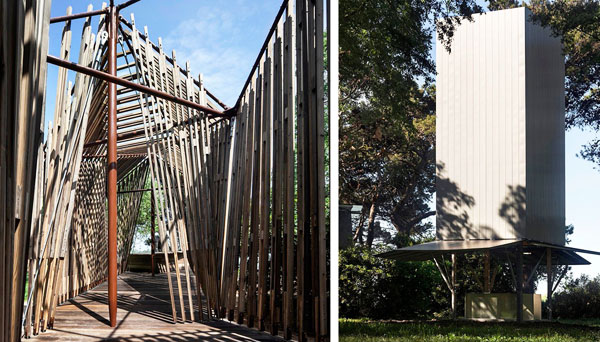
Altogether, says the Vatican, the choice of architects and their creations reflect “the universal – indeed Catholic – nature of the Church.”
Predicted Church of the Future
Actually, it is the Church of Vatican II, predicted by and approved by then Fr. Joseph Ratzinger in 1969:
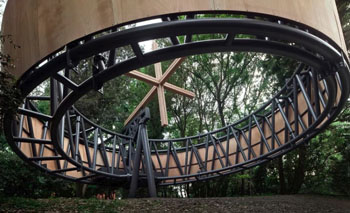
Corvalán "liberates the circle" with his nomadic church, always on the move. The circle does not touch the ground but hovers in the air, moved by the wind
Venice, the city nicknamed La Serenissima, famous for its wealth of glorious churches that majestically rise to animate the city’s skyline, certainly becomes less serene with this display of mutant monsters called chapels that the present day Vatican proudly sponsors as the Churches of the Future.
The ensemble calls to my mind the text from the Third Secret of Fatima posted on this website as deciphered by Atila Guimarães. In it, Sister Lucy writes: “Then, after some moments, we saw the Pope entering a Church, but this Church was the Church of Hell. There is no way to describe the ugliness of that place.”
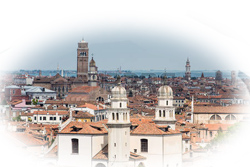

Posted May 28, 2018
______________________
______________________
 Volume I |
 Volume II |
 Volume III |
 Volume IV |
 Volume V |
 Volume VI |
 Volume VII |
 Volume VIII |
 Volume IX |
 Volume XI |
 Special Edition |
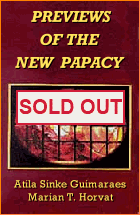 Special Edition |


